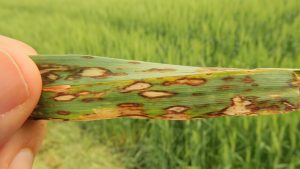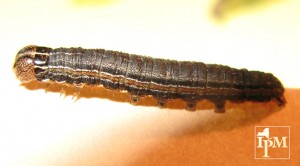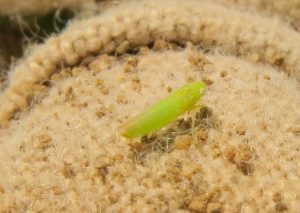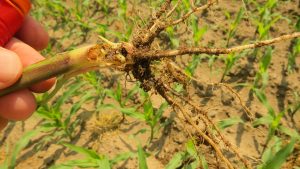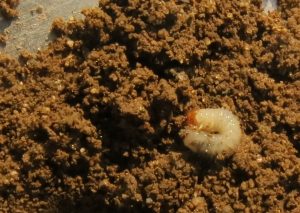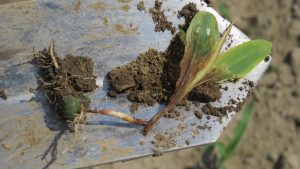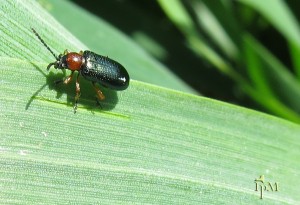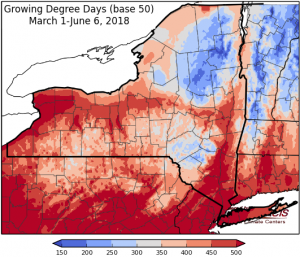Contents
View from the Field
Alfalfa Weevil on Regrowth
Jodi Letham (CCE Northwest NY Dairy and Livestock Team) and Kevin Ganoe (CCE Central NY) report finding alfalfa weevil larvae at high levels in regrowth in alfalfa. Remember the threshold for alfalfa weevil in regrowth is that 50% of the tips show feeding. See article for more information on scouting alfalfa weevil.
https://blogs.cornell.edu/ipmwpr/alfalfa-weevil-in-alfalfa/
Scald on Malting Barley
Gary Bergstrom (Cornell Extension Plant Pathologist) and Aaron Gabriel (CCE Capital District) report finding the foliar disease “scald” (Rhynchosporium secalis) on malting barley. Gary suggests that this disease may be causing some yield losses in malting barley. The photo below is the typical symptoms of scald.
Scald will overwinter on previous crop residue. The best way to control this disease is by rotation, plow under crop residue, use resistant cultivars and possibly use a fungicide if the cultivar is susceptible.
True Armyworms
There have been reports about armyworm worms in hay this week. We have been catching some armyworm moths in our pheromone traps. Keep a close eye out for this pest. It can do damage very quickly if gone unchecked.
Potato leafhopper
Potato leafhopper has been found statewide at low populations in alfalfa. If weather starts to get hot and dry this insect pest can increase very quickly.
White Grubs in Field Corn
I found a number of white grubs in a corn field this week. They were not doing economic damage but I found it interesting that they were in a field that had been corn for 12 continues years. White grubs are normally a pest in a first year corn field after sod. The feed on the roots of many different kind of grasses.
Damping Off in Corn
In the same corn field I found some seeding blight or damping off. It was not very prevalent in areas where water could collect in the row a number of seedlings had the disease.
Cereal Leaf Beetle in Small Grains
There are some reports of cereal leaf beetle starting to feed on small grains. In eastern NY this week I saw a few cereal leaf beetle adults near Valatie in Tom Kilcer’s small grains plots.
Weather Outlook – June 9, 2018
Jessica Spaccio
NOAA Northeast Regional Climate Center, Cornell University
Last week temperatures ranged from 2 degrees below normal to 6 degrees above normal. Precipitation has ranged from a quarter of an inch to 3 inches. Base 50 growing degree-days ranged from 40-140.
Warming temperatures and mostly dry conditions.
Today will be mostly sunny with temperatures in the 70s. Overnight lows will be in the upper 40s to mid 50s.
Friday will be sunny and dry with highs in the 70s to low 80s. Overnight temperatures will be in the 50s.
Saturday temperatures will be in the 70s, with a slight chance of scattered showers. Overnight temperatures will be in the 50s.
Sunday will be sunny with highs in the 70s. Overnight temperatures will be in the 50s.
Monday will be sunny with highs in the 70s. Overnight temperatures will be in the 50s.
Tuesday highs will be in the mid 70s to low 80s with a slight chance of showers. Overnight temperatures will be in the 50s.
Wednesday highs will be in the mid 70s to low 80 with scattered showers and thunderstorms possible. Overnight temperatures will be in the 50s.
The seven-day precipitation amounts will range from a tenth of an inch to three quarters of an inch.
The 8-14 day outlook (June 14-20) favors above-normal temperatures for central to northern NY, with near-normal temperatures expected for western to southeast NY. The precipitation outlook favors above-normal amounts for part of western NY, below-normal amounts for southeast NY to the capital region, and near-normal amounts for the rest of the state.
Maps of 8-14 day outlooks:
http://www.cpc.ncep.noaa.gov/products/predictions/814day/index.php
National Weather Service watch/warnings map:
US Drought Monitor
http://droughtmonitor.unl.edu/Home.aspx
Fusarium Head Blight Risk
Note that fusarium head blight risk in winter wheat is very high around much of the state. Use the Fusarium Head Blight Prediction Center to find your location and potential for risk. http://www.wheatscab.psu.edu/
New York Field Crop Pest Degree Day Accumulations for selected locations
(June 9, 2018)
| Station Location |
Alfalfa Weevil (Base 48) March 1 |
GDDs (Base 50 F) March 1 |
Seed Corn Maggot (base 39) January 1 |
Black Cutworm (Base 50) April 24 |
| Ceres | 603 | 514 | 1129 | 501 |
| Chazy | 465 | 383 | 921 | 383 |
| Geneva | 632 | 543 | 1165 | 543 |
| Highland | 730 | 636 | 1359 | 628 |
| Ithaca | 617 | 528 | 1168 | 516 |
| Massena | 510 | 426 | 967 | 426 |
| Northport (Richters) | 689 | 584 | 1388 | 563 |
| Valatie | 628 | 539 | 1162 | 534 |
| Versailles | 640 | 555 | 1285 | 548 |
| Watertown | 490 | 410 | 963 | 410 |
Accumulated Degree Days for Peak Occurrence
(50%) of Alfalfa Weevil at a given Life Stages
Stage Degree Days
Egg hatch 280 DD
Instar 1 315 DD
Instar 2 395 DD
Instar 3 470 DD
Instar 4 550 DD
Cocooning 600 DD
Pupa 725 DD
Adult emergence 815 DD
Black Cutworm Degree Days
| Degree Days | Stage | Feeding Activity |
| 0 | Moth Capture | Egg Laying |
| 90 | Eggs Hatch | |
| 91-311 | 1st to 3rd Instar | Leaf Feeding |
| 312-364 | 4th Instar | Cutting Begins |
| 365-430 | 5th Instar | Cutting Begins |
| 431-640 | 6th Instar | Cutting Slows |
| 641-989 | Pupa | No feeding |
Source: University of Minnesota Black Cutworm Trapping Network
Seed Corn Maggot Peak Flight and Fly Maggot Free Degree Days
| Base Temp = 390 F | Peak 1st Generation | Seed corn maggot fly free degree days | Peak 2nd Generation | Seed Corn maggot fly free degree days | Peak 3rd Generation | Seed Corn Maggot fly Free degree days |
| degree days | 360 | 810 | 1,080 | 1530 | 1800 | 2250 |
Source: Insect IPM for Organic Field Crops: Seed Corn Maggot by Katelin Holm and Eileen Cullen
Clipboard Checklist
Keith Waldron, NYS IPM
General
*Walk fields to check general field condition, weed issues, areas of soil erosion
*Watch for early season weeds: winter annuals, chickweed, henbit, field penny cress, shepherd’s purse, giant and common ragweed, purple deadnettle, lambsquarters, redroot pigweed, velvet leaf, Pennsylvania smartweed, common sunflower, quackgrass, foxtail
Alfalfa:
*Evaluate established legume stands for approximate days til harvest
*Monitor regrowth for alfalfa weevil, potato leafhopper
*Monitor new seedings for Pythium blight and Phytopthora Root Rot.
Small Grains:
*Monitor winter grain fields for growth stage, disease issues, cereal leaf beetle
*Check stands for diseases, cereal leaf beetle, weed escapes
*Monitor wheat for potential risk of fungal disease issues – consult Fusarium Head Blight
prediction model
Corn:
*Conduct plant population assessments, early season corn pests including seed corn maggot, white grub, wireworm, black cutworm, armyworm, slugs, diseases, weed issues, vertebrate damage
Soybeans:
*Post emergence weed evaluation, timely cultivation and/or weed management
*Conduct plant population assessments, early season corn pests including seed corn maggot, slugs, soybean aphid, diseases, weed issues, vertebrate damage
Pastures:
*Check and mend fences as needed.
*Check crop growth
*Invasive species, plants harmful to livestock
*Review/Plan rotation system
Equipment:
*Remove / clean soil and crop debris from equipment
*Arrange for custom weed control or check your own application or cultivator equipment for repairs.
*Carry appropriate / necessary NYS DEC and EPA required documents: (pesticide applicators license, pesticide labels, MSDS sheets, etc.) with application equipment
*Calibrate:
- planting equipment – maintain records on planting rate per field
- manure spreaders – maintain records on amount spread per field
- pesticide application equipment – Check nozzles, pumps, etc., recalibrate pesticide application equipment before use. Maintain pesticide use records
Storage:
* Check stored grain bins for temperature, moisture and signs of mold and insects. Aerate, core, transfer grain or treat as necessary
*Check forage allocation and anticipate feed program adjustments as forages from previous year are used up
*Plan where forages should be stored for optimum allocation next feeding season
*Mow around storage bins and facility to minimize pest hiding places
Dairy Cattle Barn Fly Management:
*Monitor animals and barn area for house fly, stable fly and other pest management needs including presence of rodents and birds.
*Check facilities for favorable fly breeding conditions: (organic matter + moisture): leaks in watering systems, roof gutters for leaks and potential overspill, drainage,
*Sanitation, sanitation, sanitation – clean animal resting areas, feed troughs, minimize source of moist organic matter i.e. fly breeding areas in barn and in adjacent animal loafing yard
* Continue fly monitoring: install “3X5″ index card fly speck monitoring cards throughout barn
*Use, replenish, replace fly management materials: sticky fly tapes/ribbons, insecticide baits, natural enemies (parasitoids), fly population monitoring (3 x 5) spot cards
*Consider purchase and release of Muscidifurax raptor and/or M. raptorellus natural enemies of house and stable fly pupae.
Dairy Cattle on Pasture:
*Monitor animals for presence of face flies, horn flies and stable flies. Action guidelines: face flies (average 10 per animal face), horn flies (average 50 / dairy per animal side, 200 / beef cattle per animal side), stable flies average 10 per animal (all four legs)
*Check feed bunk / water source locations for signs of stable fly breeding (moist undisturbed organic matter – spilled feed, round bales, etc.), minimize source of moist organic matter i.e. fly breeding areas in barn and in adjacent animal exercise yard.
*Check pasture for forage quality / quantity, rotate as appropriate
*Check pasture for vegetation poisonous to livestock
*Consider use of pasture fly traps to help reduce deer, horse and stable fly populations



